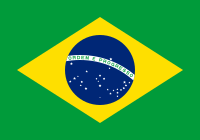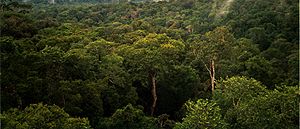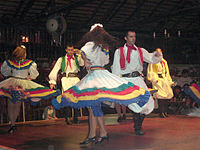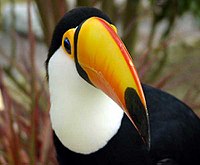Wikijunior:South America/Brazil
Part of Wikijunior South America project


Bem-vindo ao Brasil—Welcome to Brazil! Brazil is by far the largest country in South America, and the fifth largest country in the world. Brazil is located right in the middle of South America, and borders most of the other countries, but it is also very different from them. For instance, while most people in South America speak Spanish, in Brazil people speak Portuguese. Brazil is home to 190 million people, who live in twenty-six states and one Federal District (the capital, Brasília). Because Brazil is so large, it is often broken up into five geographical regions; the North, the Northeast, the Southeast, the South, and the Center-West regions.
What are Brazil's national symbols?
[edit | edit source]Brazil's flag is green with a yellow rhombus and a blue circle set with stars.The stripe across it says ordem e progresso which means order and progress. Brazil's national colors, green and yellow, represent the colors of the royal Portuguese family. Brazil once had the largest gold mines in the world. The blue circle shows the sky over Rio de Janeiro.
What are some famous places in Brazil?
[edit | edit source]Brazil is home to the Amazon River and the Amazon Rainforest. It also has two of the 30 largest cities in the world, São Paulo and Rio de Janeiro.
The steamy rainforest of the Northern Region
[edit | edit source]
The northern region of Brazil contains the Amazon, the world's largest rainforest. A rainforest is a place with lots of rain, animals, and trees. The rainforest is so big that it stretches into Brazil's neighbors—Colombia, Peru, Venezuela, Ecuador, Bolivia, Guyana, Suriname and French Guiana. In fact, the Amazon is so big that if you got all the rainforests in the rest of the world and put them all together it would not be as big as the Amazon. The Amazon Rainforest is named after the Amazon river which is the second longest river in the world.
Because the Amazon is a rainforest, life is very hot and wet. Many thousands of different types of animals and plants are found in the Amazon, as well as 2.5 million different insect species! Because the Amazon is so big, there are still some animals and plants that haven't even been discovered yet.
Unfortunately, the Amazon Rainforest is very quickly shrinking to make way for farmland and cattle. Burning the rainforest is illegal, but difficult for the police to stop because the vastness of the Amazonian region and for the money into the black market that sells wood worldwide... The burning of the forest means that many animals and plants are becoming extinct. Although lots of people are very worried about this it is unlikely that the destruction of the forest will end in the near future.
The beautiful beaches and festivals of the Northeast
[edit | edit source]One beautiful beach in the Northeastern area. This is Boa Viagem Beach. The northeastern region was the first part of Brazil to be inhabited by Europeans, and is sometimes called the heart of Brazil. Some of the oldest cities in the country are there, especially on the coast. The area's beautiful shores attract people from every part of the world. Salvador and Fortaleza are typical cities of the northeastern region. In Salvador the people have invented many dances and musical rhymes for the many festivals which are held year round.
Carnival

The grand cities of the Southeastern Region
[edit | edit source]
Southeast Brazil is the part of the country that has the most people and the most business. It contains the two famous Brazilian cities: Rio de Janeiro and São Paulo. São Paulo is Brazil's biggest city and has over 20 million people living in it. People living in São Paulo are called Paulistanos. Rio de Janeiro is also a very big city but not as big as São Paulo, with only 10 million inhabitants. The people who live in Rio (called Cariocas) are very proud of their city because it is so beautiful. Rio de Janeiro has some famous beaches, which have been mentioned in many songs and films. The city got its name (which means "January River" in Portuguese) because the city has a great bay; early Portuguese explorers discovered this bay in January and thought it was the mouth of a river, hence the name "January River."
The European-like Southern Region
[edit | edit source]
The Southern Region is very different from the rest of Brazil. The temperature is much cooler, and many of the people who live there descended from people who came to Brazil from Italy, Germany, and other countries in Europe. In some cities people still speak the languages of those countries along with Portuguese. The gaúcho is a kind of cowboy from southern Brazil: he rides his horse through the Pampas, large fields of cattle breeding. Nowadays, however, a gaúcho (or gaúcha, if female) is anyone born in Rio Grande do Sul, regardless of living in the city or in the country.
The vast fields of the Center-West Region
[edit | edit source]The Center-West Region is the least populated region in Brazil. The large fields of Cerrado are the place for big plantations of soy and cattle breeding. In central-west Brazil we find Brazil's capital, Brasília, a city constructed in the middle of the last century with street patterns shaped like an airplane! Brasília is also located near the exact center of Brazil's territory. In the central-west area there is also the Pantanal, probably the largest wetlands in the world (it is about half the size of France), where a great range of different kinds of birds, fish, mammals, reptiles and others beings live.
What important events have happened in Brazil?
[edit | edit source]Where does Brazil's name come from?
When the first Portuguese arrived in Brazil, they called this land Ilha de Vera Cruz (Island of True Cross), because they thought Brazil was an island. When they discovered that Brazil wasn't an island, the Portuguese called it Terra de Santa Cruz (Land of Holy Cross). Finally, they found a tree there that could be used to paint clothes with red color. They called this tree pau-brasil, pau means wooden stick and brasil comes from brasa which means ember. So, Brazil received its name from the tree pau-brasil.Portuguese explorer Pedro Álvares Cabral arrived in Brazil in 1500, and called the land for Portugal. Today, the Brazilians are descendants from people of many regions of the world, mainly Portuguese, Africans, and from people the people who lived there when the Portuguese arrived, the Indians (índios). There were many Indians in Brazil in ancient times, but diseases and wars against foreigners reduced Indian populations. Millions of Africans came to Brazil as slaves to work mainly in sugar cane farms.
In 1808, King João VI of Portugal, fleeing Napoleon's French army, moved the seat of government to Brazil, and made Rio de Janeiro the temporary capital of Portugal. Even after the government officially moved back to Portugal, Rio de Janeiro was thought to be a co-capital of the empire for many years, and had a significant influence on the people of Portugal.
In 1822, Brazil declared its independence from Portugal, becoming the Empire of Brazil. And the Portuguese Prince-Regent (next in line to become king of Portugal) Pedro I became Brazil's Emperor. Later on, his son, Pedro II, was chosen the second Emperor. During these times Brazil had to fight wars against its neighbors, Argentina and Paraguay, to avoid any invasion.
In 1888, Princess Isabel ended the practice of slavery. Finally, in 1889, Brazil turned into a Republic, which meant Brazil now had a President who is elected by the people, instead of an Emperor.
From a small land bordering the Atlantic Ocean, Brazil grew to be an immense country, especially when some people found gold in Minas Gerais and Goias, far away from the coast, and when Brazil started to take latex from the Amazônia.
The capital of Brazil was earlier Rio de Janeiro, and stayed there for many years. After many attempts, a new capital was created and built near the center of Brazil called Brasília in 1956. This was done for many reasons, although a major purpose was to draw the population of Brazil away from the coastal cities and instead toward the interior of the country.
During the twentieth century, Brazil went twice under Dictatorships, which is a type of government that gets a lot of power and turns against the people. When under dictatorships, Brazilians that opposed the government experienced hard times of censorship and cruelty. Today Brazil is a free country, where people are able to vote for President and express themselves with no fear. In late 2010, Brazil elected its first female president, Dilma Rousseff, who took office in January 2011.

What is the natural environment like in Brazil?
[edit | edit source]Brazil may have more different types of animals than any other country in the world. This is because Brazil is such a large country with many different forests that are dense with living things. All of Brazil is warm and some of Brazil is very rainy. There are two huge forests in Brazil. The Amazon rainforest and the Atlantic forest. Both of these forests are shrinking because people cut the trees down for lumber and also to clear the land for farming and ranching.
What types of things are made in Brazil?
[edit | edit source]Brazil produces many types of things. There are iron mines that produce iron to make into steel. Brazilians also grow coffee, soybeans, and fruit. They manufacture airplanes and cars and electrical equipment. There is also a lot of tourism and eco-tourism in Brazil. (They are known for one of the countries making the most coffee in the world) Lately, Petrobras, Brazil's largest oil company is offshore drilling along the continental shelf, it is moving Brazil from being nearly 100 percent dependent on foreign oil imports toward becoming a net oil exporter in the next few years. [1]
What is School like in Brazil?
[edit | edit source]School varies in Brazil, there are many excellent schools however they are private schools and cost a lot of money to go to. The ones that are public can be much worse. Because many people in Brazil aren't very rich, many children will not get to go to a good school.
What sports are popular in Brazil?
[edit | edit source]
Soccer/Football is the most popular sport in Brazil - the country has won the football World Cup more times than any other country. Swimming and Volleyball are some other competitive sports that are played.
Who are some famous people from Brazil?
[edit | edit source]Some people from Brazil have become famous all over the world.
One of the best-known is Pelé, a soccer player that many people believe was the best ever. Ayrton Senna was a Brazilian three-times Formula One world champion. He won in 1988, 1990, 1991.
- ↑ Brazil's giant offshore oil discoveries http://www.wnd.com/news/article.asp?ARTICLE_ID=47265 Read more: Brazil's giant offshore oil discoveries http://www.wnd.com/news/article.asp?ARTICLE_ID=47265#ixzz1PRDFmJzN